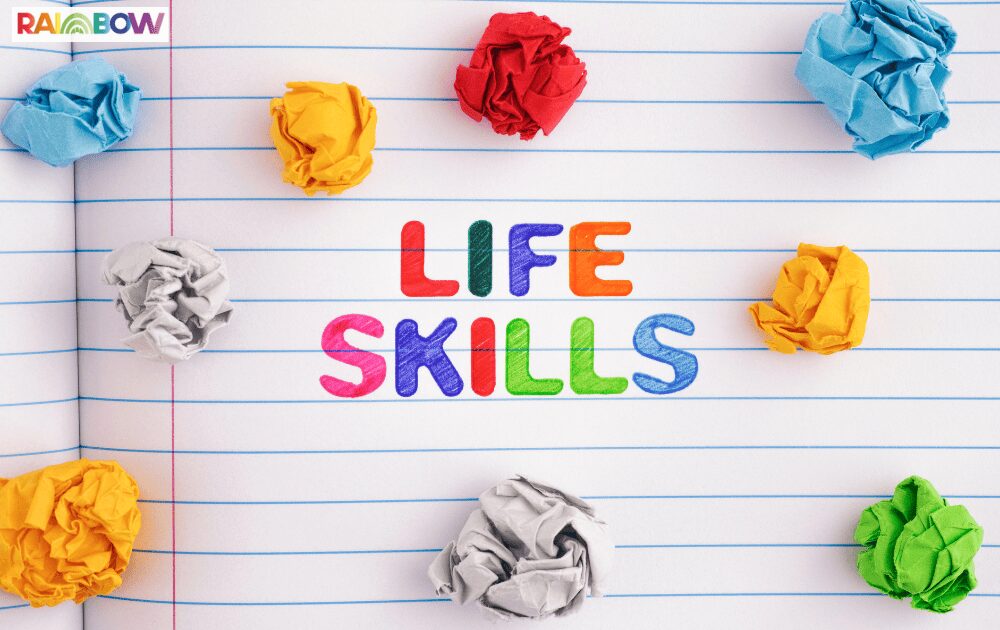From enhancing communication and social interactions to fostering independence and self-care, this guide equips parents, caregivers, and educators with the tools to support and empower kids with ASD. By focusing on important like skills and habits, such as brushing teeth, washing hands, grooming, and dressing appropriately, individuals with autism can navigate social situations with confidence and improve their daily lives.

Essential Life Skills for Kids with Autism
From communication and social interactions to daily routines and self-care, honing essential life skills empowers children with autism to engage meaningfully with their environment and lead fulfilling lives. These skills serve as the building blocks for their independence and success.
1. Improving Communication Skills
Teaching effective communication strategies is essential for individuals with autism to express themselves, build relationships, and navigate social situations. In this section, we will explore communication strategies specifically designed for individuals with autism and the tools that can aid in teaching communication skills.
Communication Strategies for Autism
Teaching communication skills to individuals with autism requires specialized strategies that cater to their unique needs. Here are some effective communication strategies:
- Visual Aids: Visual supports, such as visual schedules, social stories, and visual cues, can be powerful tools for individuals with autism. Visual aids provide clear and concrete information, helping individuals understand and remember important concepts and instructions.
- Social Stories: Social stories are narratives that describe social situations, behaviors, and expectations in a structured and visual manner. They can help individuals with autism learn appropriate responses, understand social cues, and navigate social interactions.
- Games and Role-Playing Activities: Interactive games and role-playing activities provide opportunities for practicing social skills and communication in a fun and engaging way. These activities can help individuals with autism learn turn-taking, expressing feelings, and problem-solving in a safe and supportive environment.
- Augmentative and Alternative Communication (AAC): AAC devices, such as communication boards, picture exchange systems, and speech-generating devices, can be valuable tools for individuals with limited verbal communication skills. AAC systems provide alternative means of communication, allowing individuals to express their thoughts, needs, and desires effectively.
2. Developing Hygiene Habits
Developing good hygiene habits is crucial for individuals with autism as it helps them maintain their health, prevent illness, and promotes social acceptance. By understanding the importance of hygiene, individuals with autism can take control of their personal care and build positive relationships with peers and society.
Proper hygiene habits also contribute to overall self-esteem and confidence. When individuals with autism feel clean and presentable, they are more likely to engage in social interactions, participate in activities, and embrace new experiences.
Strategies for Teaching Hygiene
Teaching personal hygiene to individuals with autism requires patience, consistency, and tailored strategies to fit their unique needs. Here are some effective strategies to consider:
- Visual Supports: Utilize visual supports, such as visual schedules, social stories, and visual cues, to help individuals with autism understand and remember the steps involved in personal hygiene routines. Visual supports provide clear and concrete instructions, reducing anxiety and promoting independence.
- Modeling and Practice: Demonstrate each step of the hygiene routine yourself, and encourage individuals with autism to imitate your actions. Provide ample opportunities for practice and reinforce their efforts with praise and positive reinforcement.
- Social Stories: Create social stories that specifically address personal hygiene routines. Social stories use simple language and visual aids to explain the purpose and steps of each hygiene activity. These stories can be personalized to suit the individual’s preferences and needs.
- Break Tasks Down: Break down each hygiene task into smaller, manageable steps. This helps individuals with autism focus on one step at a time and reduces the feeling of being overwhelmed. Gradually increase the complexity of the tasks as they become more comfortable and proficient.
- Sensory Considerations: Be mindful of sensory sensitivities that individuals with autism may experience. Adjust the environment to accommodate their sensory needs, such as using soft towels, providing headphones for noise reduction, or using specific soaps or toothpaste that they find comfortable.
Remember, teaching personal hygiene to individuals with autism is an ongoing process. It is important to be patient, understanding, and consistent in your approach. Promoting and reinforcing good hygiene habits can help individuals with autism develop essential life skills that contribute to their overall well-being and social integration.

3. Learning Cleaning Skills
Teaching cleaning skills to individuals with autism is an important aspect of their daily living. By learning these skills, individuals with autism can develop independence, responsibility, and a sense of accomplishment. Breaking down cleaning tasks into smaller steps, providing visual aids, and using task analysis can be effective strategies for teaching cleaning skills to individuals with autism.
Benefits of Chores for Autism
Engaging individuals with autism in chores and cleaning tasks can have numerous benefits. It promotes independence, responsibility, and a sense of contribution to the household. Additionally, participating in cleaning activities can improve sensory integration, enhance fine motor skills, and develop coordination.
Cleaning tasks also provide opportunities for individuals with autism to practice following instructions, sequencing steps, and staying organized. These skills are not only valuable for maintaining a clean and orderly living environment but also for fostering important life skills that can be applied in various contexts.
Techniques for Teaching Cleaning
To effectively teach cleaning skills to individuals with autism, it is important to use techniques that are tailored to their specific needs and learning styles. Here are some strategies that can be helpful:
- Break tasks into smaller steps: Cleaning tasks can be overwhelming, so breaking them down into smaller, manageable steps is crucial. Use visual aids such as checklists or visual schedules to help individuals understand and remember the sequence of steps involved in each task.
- Provide visual cues: Visual cues can be highly beneficial for individuals with autism. Use visual prompts such as pictures, diagrams, or written instructions to reinforce the steps involved in cleaning tasks. These visual cues can serve as reminders and help individuals with autism stay on track.
- Create a structured routine: Establishing a consistent and structured routine for cleaning tasks can provide individuals with autism a sense of predictability and reduce anxiety. Clearly define the time and frequency of cleaning tasks and incorporate them into a daily or weekly schedule.
- Use positive reinforcement: Positive reinforcement plays a significant role in motivating individuals with autism. Offer praise, rewards, or a token system to acknowledge their efforts in completing cleaning tasks. Celebrate their accomplishments and highlight the positive impact they have made through their contributions.
- Model and practice: Demonstrate each cleaning task step-by-step and encourage individuals to observe and imitate. Practice the tasks together, providing guidance and support as needed. Gradually fade your assistance and encourage independence as their skills develop.
By implementing these techniques and strategies, individuals with autism can develop essential cleaning skills, fostering their independence and self-confidence. Learning these skills at a young age and practicing them regularly can have a positive impact on their overall development and prepare them for a more independent future.

4. Fostering Self-Advocacy
Empowering individuals with autism to become self-advocates is a vital aspect of their personal growth and development. Teaching self-advocacy skills equips them with the tools they need to express their needs, make choices, and advocate for themselves in various social settings. This not only promotes self-confidence and autonomy but also facilitates effective communication and interaction with others.
Empowering Autistic Individuals
Empowerment lies at the heart of fostering self-advocacy in individuals with autism. By empowering them, we enable them to take an active role in their own lives, decisions, and well-being. This sense of empowerment helps build self-esteem and a positive self-image, enabling individuals with autism to navigate the world with resilience and confidence.
Empowering autistic individuals can be achieved through various approaches, including:
- Building Trust: Establishing a foundation of trust and understanding is essential for empowering autistic individuals. Creating a safe and supportive environment allows them to express themselves freely and develop a sense of agency.
- Recognizing Strengths: Identifying and highlighting strengths and abilities helps individuals with autism recognize their unique qualities and potential. By focusing on their strengths, we can boost their self-esteem and encourage them to embrace challenges.
- Promoting Self-Determination: Encouraging autistic individuals to participate in decision-making processes and advocating for their own needs fosters a sense of ownership over their lives. This involvement allows them to develop problem-solving skills and enhances their ability to communicate their desires effectively.
5. Building Self-Advocacy Skills
Building self-advocacy skills involves providing individuals with autism the necessary tools and strategies to effectively communicate their needs and preferences. Here are some key aspects of developing self-advocacy skills:
- Communication Skills: Enhancing communication skills is crucial for self-advocacy. Teaching alternative communication methods, such as the use of AAC devices, can help individuals with autism express their thoughts, desires, and concerns more effectively.
- Self-Awareness: Developing self-awareness helps individuals with autism understand their strengths, challenges, and personal preferences. This knowledge enables them to articulate their needs and make informed decisions.
- Social Skills: Building social skills is vital for self-advocacy. Teaching individuals with autism how to navigate social situations, understand social cues, and assert their boundaries empowers them to become self-advocates in various social contexts.
- Problem-Solving: Equipping individuals with autism with problem-solving strategies enhances their ability to handle challenges and make decisions independently. Encouraging the use of logical reasoning and providing guidance through real-life scenarios can help develop their problem-solving skills.
Fostering self-advocacy skills in individuals with autism empowers them to actively participate in their own lives, advocate for themselves, and navigate the complexities of the world with confidence. This holistic approach promotes independence, adaptability, and improved quality of life for individuals with autism.
5. Enhancing Problem-Solving Abilities
Problem-solving skills are essential for individuals with autism, as they equip them with the ability to effectively tackle challenges and find solutions independently. By focusing on enhancing problem-solving abilities, individuals with autism can develop valuable life skills that will benefit them in various aspects of their daily lives.
Problem-Solving Strategies
Teaching problem-solving strategies to individuals with autism involves breaking down the process into manageable steps. Here are some strategies that can be helpful:
- Identifying the problem: Encourage individuals with autism to recognize and define the problem they are facing. This step involves understanding the specific issue at hand and expressing it in a clear and concise manner.
- Brainstorming solutions: Once the problem is identified, individuals with autism can be encouraged to generate different possible solutions. This step promotes creativity and flexibility in thinking.
- Considering consequences: Help individuals with autism understand the potential outcomes of each solution. Discuss the advantages and disadvantages of each option, weighing the potential consequences.
- Selecting the most appropriate solution: Guide individuals with autism in evaluating the different solutions and selecting the most suitable one. This involves considering factors such as feasibility, resources available, and potential long-term effects.
By teaching problem-solving strategies, individuals with autism can develop their critical thinking skills and become more adept at finding effective solutions to various challenges they may encounter.
6. Encouraging Independent Solutions
Encouraging individuals with autism to find independent solutions is an important aspect of fostering their problem-solving abilities. Here are some techniques to promote independent problem-solving:
- Provide guidance and support: Offer guidance and support as needed, but also encourage individuals with autism to take the lead in finding solutions. This helps build their confidence and autonomy.
- Break tasks into manageable steps: Complex problems can be overwhelming, so breaking them down into smaller, more manageable steps can make problem-solving more approachable for individuals with autism.
- Promote self-reflection: Encourage individuals with autism to reflect on their problem-solving process. This involves evaluating the effectiveness of their solutions, identifying areas for improvement, and learning from their experiences.
- Reinforce persistence and resilience: Problem-solving can be challenging, and individuals with autism may encounter setbacks or obstacles along the way. Encourage perseverance and resilience, emphasizing that setbacks are part of the learning process.
These skills are transferable to various aspects of their lives, enabling them to navigate challenges and find solutions in a more independent and adaptive manner. By incorporating problem-solving strategies into daily activities and routines, individuals with autism can develop their abilities and enhance their overall life skills.

Starting Early with Life Skills
Teaching life skills at an early age is crucial. By starting early, parents and caregivers can lay a strong foundation for the development of essential skills that promote independence and enhance the quality of life for autistic children. I
Learning self-help skills can be challenging for individuals with autism, but it is essential for their overall development and future independence. Starting early allows children to gradually acquire and practice these skills, building confidence and familiarity with daily routines. By breaking up their daily routines into manageable tasks and creating checklists, parents and caregivers can help autistic children adjust to the structure and predictability of their days. This can reduce anxiety, improve organization, and foster a sense of accomplishment.
Research suggests that early intervention and the development of life skills significantly contribute to positive outcomes for individuals with autism as well as their families. These skills not only facilitate day-to-day functioning but also promote self-assurance, adaptability, and a willingness to learn new tasks. Furthermore, early skill development sets the stage for successful transitions into adulthood, where independence becomes increasingly important.
If you’re looking for high-quality ABA programs in New Jersey, Texas, Oklahoma, or Georgia, look no further than Rainbow ABA. Our experienced therapists are dedicated to providing personalized care tailored to each child’s unique needs. Contact us today to learn more about our ABA programs and schedule a consultation!


